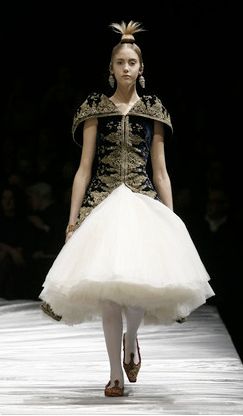“McQueen” Documentary Depicts The Man Behind the Handbags

Haute couture is offered to global fashion consumers as a delicacy — a rarity few can afford and even fewer deserve. The message is incredibly clear: high fashion is not only an art but a privilege to engage with. The veil of this exclusive industry is broken only through powerful faces who become cultural icons, such as Hubert de Givenchy, Tom Ford, Karl Lagerfield and Jean Paul Gaultier.
However, the line between exclusive creator and famed icon has become increasingly more difficult to cross in recent decades. A rare and largely unexpected breach to this barrier is the “bad boy” of fashion, Lee Alexander McQueen. Despite the designer’s early infamy and expansive body of work, he died of suicide at an early age, thereby memorializing his status as a tortured artist.
Eight years after the passing of McQueen, directors Ian Bonhôte and Peter Ettedgui partnered to honor the memory and works of the late creator through the documentary “McQueen.” Bonhôte’s commercial expertise and Ettedgui’s documentarian background uniquely fuse together to create a seamlessly united voice, which approaches McQueen’s works in both a humanistic and coolly materialistic manner. The result of the partnership is a narrative that is one part triumphant, one part grim and completely haunting.
Before going into the designer’s artistic inclinations, the film opens on an intimate scene of a young McQueen working in a dingy, poorly lit space. Immediately, the red tape blocking the viewer from McQueen’s alleged untouchability is cut.
The designer is not introduced as McQueen but instead as Lee, a poor and uncertain young man from Stratford, England. Within seconds of the film beginning to roll, the mythology surrounding McQueen starts dissolving until the narrative is something far more relatable for the audience. The choice of this construction instantly creates a sympathetic bond between the viewer and the designer, a bond which the film maintains as it follows McQueen along his path towards self-discovery and ultimate fame.
The lens quickly shifts away from McQueen, a the self-made hometown hero, towards the dark spiral his work went into during the years after launching his eponymous brand.
Focusing on obscenity as the designer’s defining core, the directors carefully paint McQueen’s work as something transcendent and grotesquely touching. Through deft and strategic editing, it becomes apparent that his personal traumas are inseparable from the nauseating postures of his work. Any piece that McQueen produced is not only a work of art but also a manifestation of his dark history. Impressively, the film avoids romanticizing the tale of the stereotypical tortured artist and instead takes a neutral and analytical approach to many of McQueen’s highly controversial lines. Leaving the dialogue ambiguous, the directors provide the viewer with all the necessary tools to form their own opinions on McQueen’s moral and artistic standards.
Particularly on McQueen’s 1995 Highland Rape line, Bonhôte and Ettedgui highlight the distressing controversy between whether the work empowers victims or perpetuates misogynistic exploitation. The line featured women with torn dresses, exposed breasts and disheveled hair and makeup stumbling onto the runway. The works were ripped apart by many popular media outlets and considered a cheap cry for attention on the designer’s part. However, the viewer feels almost as if McQueen embodies both the views of the victim and the perpetrator. He is both innocent and entirely guilty within his own narrative — a victim of abuse and a contentious creator, creating a complex milieu of feelings for the consumer.
The lack of McQueen’s own opinions on his work is one of the few downsides of the film. The viewer desires the ability to draw lines from McQueen’s traumas to their manifestations in his work, yet this call remains unanswered throughout the film.
While Bonhôte and Ettedgui allow little room for thinking there is no relation, they do little more to connect the dots for their audience. While this can be excused on the grounds of not knowing McQueen’s own internal reflections, there were other factors that the directors could have more easily remedied or addressed.
While the work is undeniably captivating, many of the early tapes diminish the prowess of the physical works they depict. There is something missing from McQueen’s work that the viewers are not fully able to see for themselves. To insinuate that the screen can contain the experience of sharing the physical presence of his art is a betrayal to his creations.
However, this can hardly be attributed to any fault of the filmmakers but is instead a recommendation that the viewers complement their viewing of the film with a visit to an exhibit featuring McQueen’s work.
Despite “McQueen” facing several challenges, the film is an immersive and intelligent work that breaks beyond a trend of overly scripted and stiff fashion documentaries.
Due to the copious amounts of attention given to the most minute details of McQueen’s work, the film creates a beautiful mess of a story. The narrative’s careful following of the designer’s past proves essential in dissecting his influences and the perfect storm that led to McQueen’s ultimate demise. “McQueen” is both inspiring and gaunt — truly achieving the designer’s vision of having a body of work that doesn’t “feel like you just had Sunday lunch,” but instead leaves you “repulsed and exhilarated.”
The film ultimately shows that McQueen’s life and work are complex and indistinguishable from one another. He is both a saint and a deviant within the world of fashion — rarely palatable, but always delicious.





Comments ()